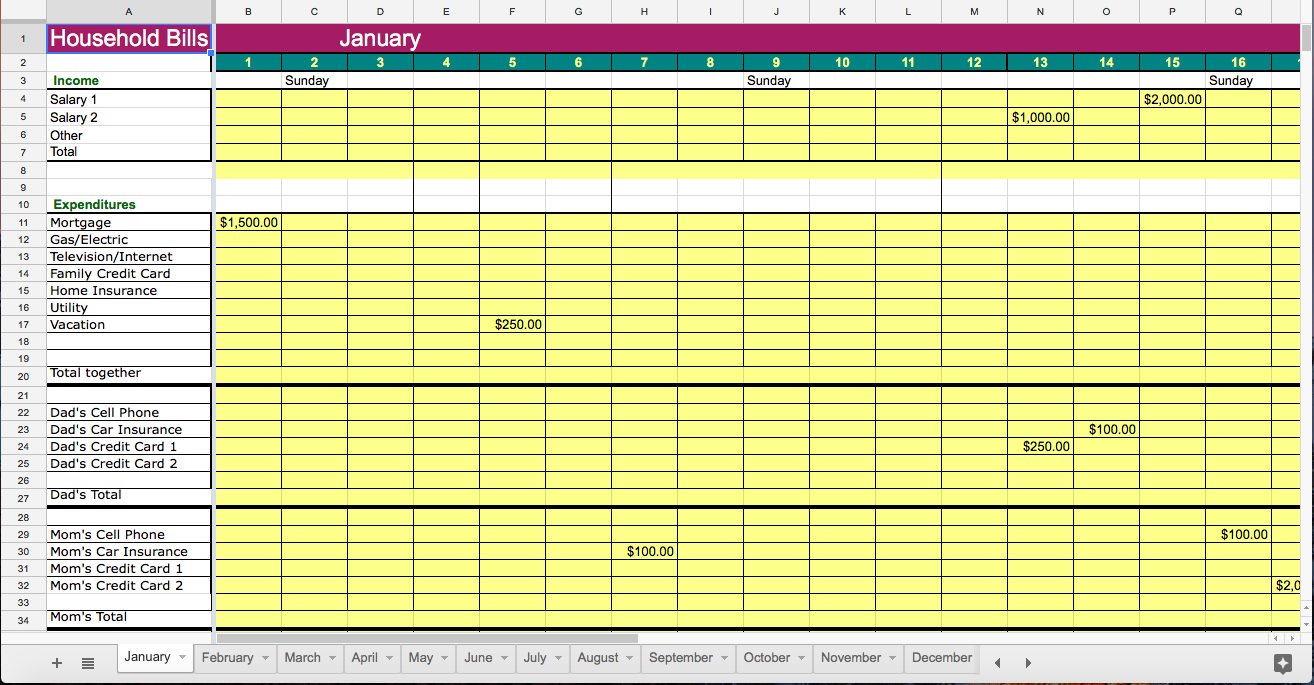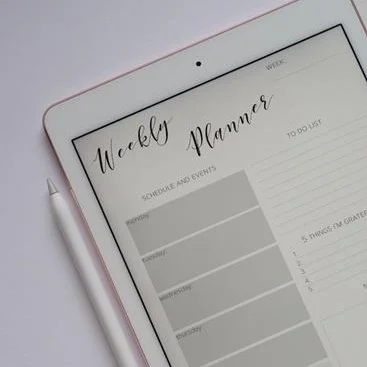With so much to do, sitting down to pay bills is an often forgotten and rushed task. We either forget to do it, or don't have all the bills in one place, so occasionally things slip through the cracks. Because of this, I created a system for myself so that I never miss a bill.
In order to keep track of all of the payments I need to make each month, I put together a spreadsheet of all of our household bills and when they are due. This helps me keep track of due dates without having to worry about if I received a physical bill or not.
In our household, I do all of the bill paying. Therefore, my husband gives me his portion of the bill money, and I issue all the payments. This spreadsheet also helps me determine how much he owes for the month to cover the bills.
In general, its easier to have one person in charge of bill payment so no-one assumes the other person already paid a bill and no payments are duplicated. On the other hand, the other person should know how you use the spreadsheet and where to find it so that if something happens to the normal bill payer, the other person can take over.
The first section of bills on my spreadsheet are joint bills. This includes the mortgage, electric, insurance, utilities, cable, and vacation. The next section consists of my husband's bills including his credit cards, phone and car insurance. The third section is for my bills: credit cards, phone bill, and my car payment.
Across the top I have the days of the month. For each monthly bill, I find the date that it's due, and in that column I put the estimated cost. Therefore, each bill should have a number in it's row, on it's due date, even if the number is just $0.00.
I keep the spreadsheet a month ahead. So if I am about to start paying my April bills, I will duplicate the tab and label it as May. This way I don't have to keep typing in numbers each month. I do this before I start making payments for the month so that nothing is already highlighted. When I start the next month, I will already have a clean spreadsheet with the expected payments on their respective due dates.
Below is a sample spreadsheet. Of course all the numbers are made up, but you can get the idea.
At the top, you can see a section labeled income. If you are concerned with overspending you can use this to track your income as it relates to your bills. At this point, our bills are generally consistent, so I don't use this section much. When baby number three comes, we may need to re-evaluate.
You can use the income section to document the amounts and dates of your paychecks. On the right your income will be totaled for the month. At the very bottom, of the right is the total of all the bill payments. You can compare these two numbers to ensure that your payments are less than your income.
Every Sunday is bill day for me. I look at the week ahead and pay all the bills for the week. I generally pay everything online so I can spread it out during the week or make sure that if I get paid on Monday and the bill isn't due until Wednesday, I can schedule payment for after payday.
Often I will schedule payments up to the following Tuesday, that way if something comes up and I am unable to pay the bills on Sunday, I have some leeway to get it done Monday or Tuesday. Once a bill is paid, I highlight it in a different color, so I know it's paid. You can see that in my example below, the payment amounts are highlighted in orange.
On the right side of the spreadsheet, I calculate my totals.
As you can see, I total our joint bills which in the example comes to $2,120.00. I then total what my husband owes. In the example, Dad's total comes to 50% of the joint bills plus his personal bills. You can determine the percentage of the joint bills per person based on your incomes or however you see fit. Just make sure it totals 100%!
I do the same for my bills. In the example, you can see that the total for Mom is .5 times the total joint bills plus the sum of her 4 bills on the bottom.
In real life, my husband works part time and stays home with our kids while I work full-time. Therefore, our split isn't 50-50. It's important to find what works for you and your family's situation. You can just change the percent amount in the formula to see what the new total would be.
The final total at the bottom is the total bill payments for the month. In general, I like to check this against our total income for the month to make sure that we are not overspending. This isn't necessarily the best check for how much you are spending though, unless you pay off your credit cards in full each month. It also doesn't take into account what you pay for in cash, but it is a good frame of reference.
Did you find this payment breakdown helpful? Do you wish you had this spreadsheet to help you pay your bills? Well, not to worry! Just fill out the form below and I will send you a copy of my spreadsheet for free.
Just fill in your bills on the left and your payment amounts in the rows and let this spreadsheet help you keep track of your spending and get all your bills paid on time!
Cheers,
Emily
















